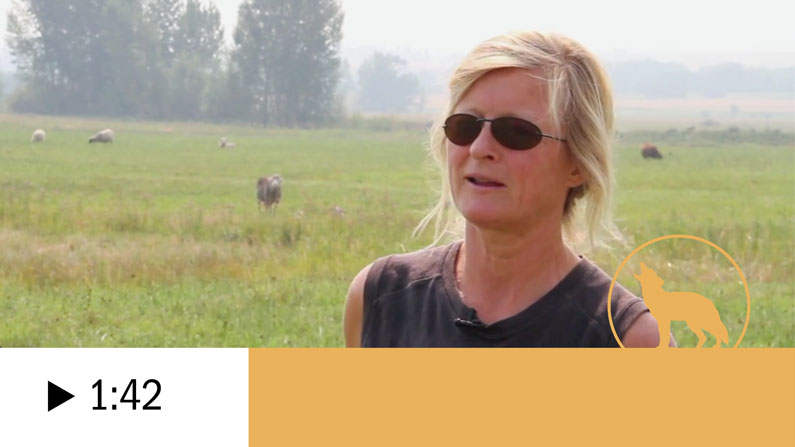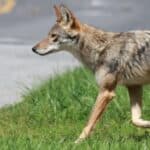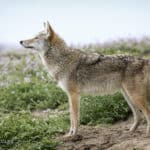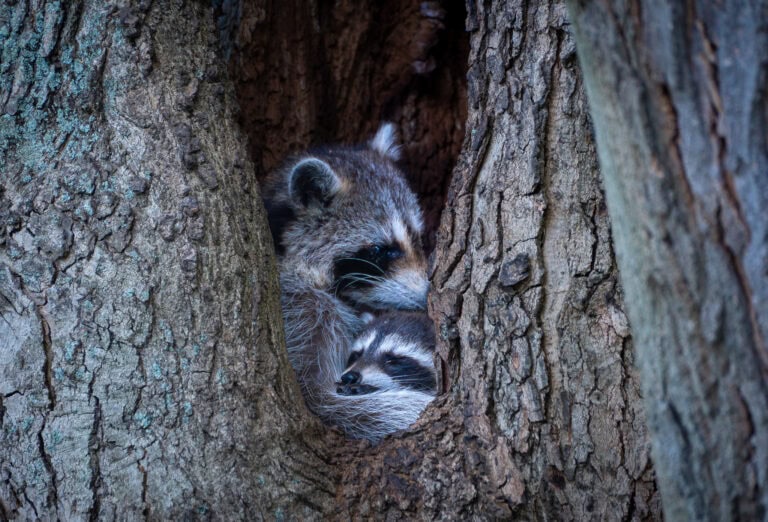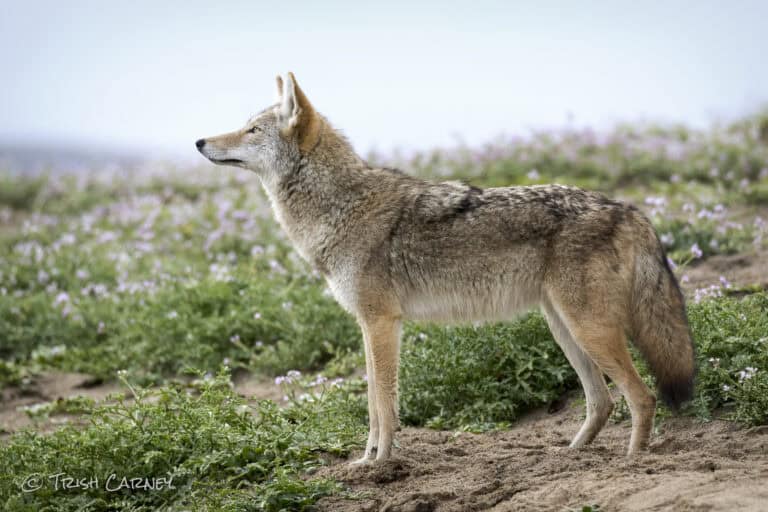Project Coyote’s Camilla Fox interviewed Becky Weed, who serves on Project Coyote’s Advisory Board, about her experiences, perceptions and views as a predator-friendly sheep rancher in Belgrade, Montana, where she and her husband raise sheep while peacefully coexisting with their wild neighbors that include coyotes, bears, mountain lions, foxes, eagles, and—most recently—wolves.
Becky, please describe a little of your background and the work you do, and how it relates to predator protection.
I’ve been working on this ranch for thirty years with my husband Dave Tyler, and that time has been an essential part of my education about grassland, predators, the people who want to kill them, and how all this fits into our agricultural culture. But my pre-ranching background has been equally important. I spent my elementary school and college years in urban America. I spent my junior high and high school years, as well as graduate school and subsequent employment, living in rural America.
Additionally, I spent a great deal of time in a few of the wildest places on earth (Greenland, Alaska, Antarctica, Northwest Territories), which has shaped my perceptions of the earth and the role of agriculture. Geology/geochemistry jobs I held before I began ranching have also influenced my understanding of how the earth works, and the whole cumulative motley collection of my life has convinced me that we ignore the natural systems that we reside in at our peril (and everyone else’s).
On a more nuts and bolts level, I served on the Board of the Predator Conservation Alliance, an organization that has since morphed into People & Carnivores. I subsequently served on the Board of the Wild Farm Alliance and the Montana Board of Livestock. Both of those roles (in very different ways!) helped broaden my understanding of and interest in the agriculture/conservation interface. Thus, in recent years I have not been involved in predator protection per se, but remain connected to predator issues through my work on our ranch, our wool mill, and other ag/conservation work.
What type of predators do you typically see at your ranch?
Coyotes are the carnivores that we see most often, and certainly hear most frequently. Other predators seem to go through phases, depending on what season it is or what changes are happening in the broader neighborhood. Over the years we have had seasons where coyotes, foxes, black bears, mountain lions, bald eagles and golden eagles have been more or less apparent. Wolves have been spotted less than half a mile away from our ranch, but only once in the thirty years we’ve been here. Other than coyotes and raptors, predators don’t commonly show up in the daylight hours, but those ‘routine’ appearances by coyotes and raptors are always special. We don’t live in an extremely remote place. It is always valuable to be reminded that this land is home to someone else besides us; and we are most conscious of that fact at the edge of night.
What approaches do you use to protect your livestock from predators?
We use a combination of approaches. Our guard animals (right now a dog and a burro) are the most obvious tools, but other things play into our approach. Managing pasture in ways that allow the guard animals to keep an eye on the whole flock is helpful. A combination of temporary and permanent fencing allows for that, and is also a grass-management tool. That enables not only good animal husbandry, but also means that we don’t wreck the natural prey base for native carnivores. Mice, gophers and white-tailed deer are almost always available to coyotes and foxes here, and that serves our sheep well.
At certain times other approaches have been necessary. About ten years ago the mule deer population in the mountains behind us crashed due to disease, so the mountain lions came down in the valley looking for prey. They found both ewes and lambs here, and until we started going out at unpredictable hours with a powerful flashlight, they did significant damage. They also inspired us to get our first guard dog. We had been relying on llamas, but the llamas became less effective after about eight years so it was time for a transition anyway. One was scared and one was bored (or at least that’s the way we interpreted their actions).
During another period of a few years, we had abundant fox dens in the neighborhood. There was happy coexistence for a while as we watched the foxes hunt ground squirrels amidst the lambing ewes. But then a much bigger fox moved in and started killing lambs, and disrupting all the foxes. He got so that he could take down 40-pound lambs. On a tip from a friend I started leaving a few mothballs just outside the entrance of the nearest fox dens, hoping to make the foxes feel unwelcome. This seemed to help, but I certainly can’t prove it; perhaps my trespassing in their territory did the trick—or maybe it was just a coincidence that they stopped being a problem when they did.
A few years ago I got a call from Ian Whalen, the Australian rancher who developed Foxlights, and I now use a couple of them during key seasons, but I haven’t really given them a true test because our livestock guard dog is the dominant force in the pasture with the sheep. Recently I ran into a friend who has been using Foxlights for a few years on the perimeter of a calving pasture near Glacier National Park. He says they work best if he places them at 200-yard intervals and moves them every few days.
Non-lethal predator management is like any integrated pest management (IPM) approach—it’s about understanding ecological context, finding multiple tools and making thoughtful cost-benefit analyses.
The bottom line in predator management is adaptation. Conditions change, predators change, so we must learn and adapt. A sense of commitment is the most essential tool to achieving coexistence. We should aim high; low expectations have a way of becoming self-fulfilling prophecies.
What is origin of the “Predator-Friendly” designation for your products, and what does it mean?
The term “predator friendly” came into common usage in the early 1990s when two friends living near Livingston, Montana—a rancher and a community organizer—dreamt up a way to harness market power that would help ranchers, rural communities and wildlife all at the same time. They gathered a group of people ranging from Bob Crabtree, a predator biologist; Cindy Owings, a clothing designer; a few ranchers; and some others to start a certification program. They devised the term “predator friendly,” drew up an affidavit, hired an artist to design a logo, and things developed from there. Accordingly, certified producers do not shoot, trap or poison native carnivores—the details are spelled out in the affidavit. The certification has shifted its home over the years, but it is now administered by Wildlife Friendly Enterprise Network, an organization that also administers a broader wildlife-friendly approach that goes beyond carnivores. I was a latecomer to that initial founding group. I was skeptical about the name—as I was leery of any marketing gimmicks—but these people seemed genuine in their commitment to both wildlife and rural communities. So, sometime around 1994, my husband and I decided to participate and see if we could help make it real. The term “predator friendly” is both a marketing tool for producers who want to add value to their products, and a tool for producers and consumers to help educate each other about the risks and rewards of farming and ranching as if nature matters.
How would you describe the ecological importance of predators and other wildlife?
I see predators as one important part of a complex assemblage of biodiversity (ranging from microscopic to mega-fauna), which is essential for the long-term healthy functioning of the earth’s processes. There is a vast biological literature that analyzes and describes this more fully than I can. I urge people to access that literature to gain a more thorough animal-centric understanding of the earth. It is very interesting, and inspiring if you’re a rancher questioning the wisdom of this crazy predator-friendly idea. I confess that my background as a geologist influences me, as much as particular animal histories. This is way the earth works—get used to it, and enjoy it.
Wildlife Killing Contests have been described by proponents as effective for controlling predator populations and reducing conflicts. What is your view on this?
My view is strongly influenced by biological data: mass killings are only a temporary salve for those who don’t like predators, or those who like to shoot stuff. They don’t really help ranchers or ecosystems. My own bias is that they’re a cowardly proxy for power, designed by people who feel powerless. Humans can do better. I don’t spend a lot of time fighting them. Focusing on more positive things people can do hits the mark better for me.
What are your thoughts on the USDA Wildlife Services program’s techniques, such as aerial gunning, snares and traps, for addressing predator-rancher conflicts?
Wildlife Services’ lethal wildlife programs are temporary and unsatisfactory Band-Aids on non-superficial wounds. They have often been designed and executed by well-meaning people, but they are not effective in the long run and are disproportionately costly. I recognize that Wildlife Services has come to play an important role in the culture of many rural U.S. communities, and so many people are reluctant to let go of both tradition and what they can see. But I wish they could understand that lethal management offers only temporary help. I have no desire to sugarcoat the rogue components that are indefensible, but I also do not demonize all Wildlife Services employees with a broad brush. Some have intimate knowledge of a landscape and people that we cannot afford to ignore. Decades of effort to simply abolish the entire institution have failed; more progress is underway to try to shift mindsets instead. Probably a spectrum of approaches would be most effective. I respect both external and internal efforts to change the agency.
How would you advise other ranchers to evaluate what would be the most effective livestock protection for them?
Let your curiosity be your guide and learn from your land, your neighbors, and from people you might find only through books or travel. Caring for your land and the landscape is like caring for your body—it has to be individualized, and you know it best, so don’t take anybody’s word as gospel. Biologists are helpful, but they have prejudices and blind spots too. Try different approaches and don’t be overly discouraged by failure. It will happen and you’ll get another chance. Try not to set low expectations, which, as I mentioned previously,become a self-fulfilling prophecy.



